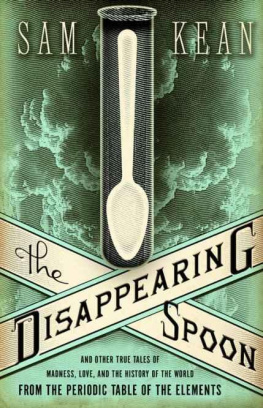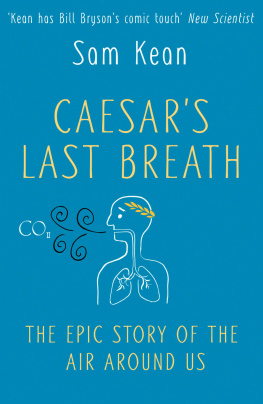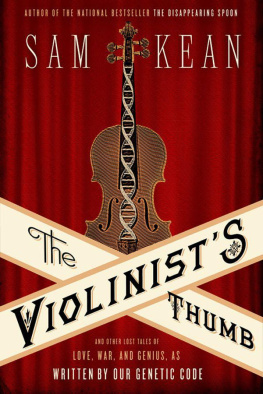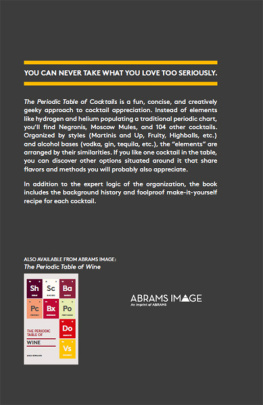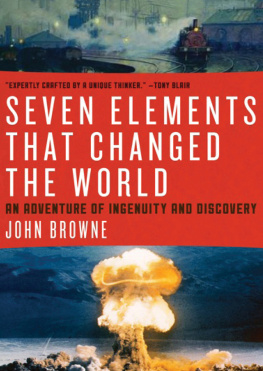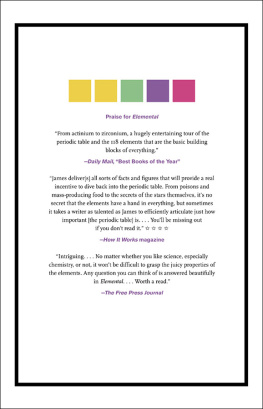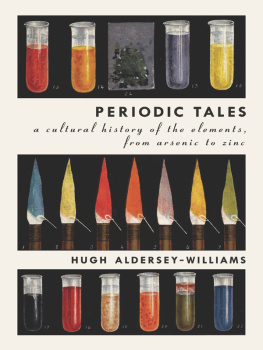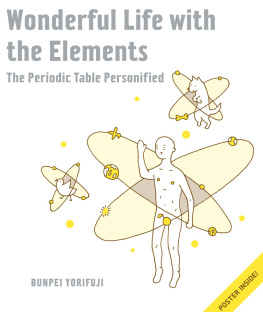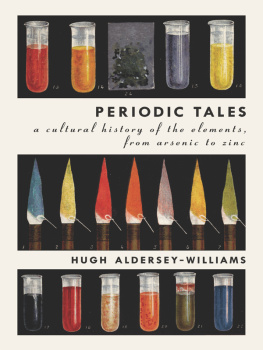Copyright 2010 by Sam Kean
All rights reserved. Except as permitted under the U.S. Copyright Act of 1976, no part of this publication may be reproduced, distributed, or transmitted in any form or by any means, or stored in a database or retrieval system, without the prior written permission of the publisher.
Little, Brown and Company
Hachette Book Group
237 Park Avenue
New York, NY 10017
Visit our website at www.HachetteBookGroup.com
www.twitter.com/littlebrown
Little, Brown and Company is a division of Hachette Book Group, Inc. The Little, Brown name and logo are trademarks of Hachette Book Group, Inc.
First eBook Edition: July 2010
ISBN: 978-0-316-08908-1
CONTENTS
PART I
ORIENTATION: COLUMN BY COLUMN, ROW BY ROW
PART II
MAKING ATOMS, BREAKING ATOMS
PART III
PERIODIC CONFUSION: THE EMERGENCE OF COMPLEXITY
PART IV
THE ELEMENTS OF HUMAN CHARACTER
PART V
ELEMENT SCIENCE TODAY AND TOMORROW

A s a child in the early 1980s, I tended to talk with things in my mouthfood, dentists tubes, balloons that would fly away, whateverand if no one else was around, Id talk anyway. This habit led to my fascination with the periodic table the first time I was left alone with a thermometer under my tongue. I came down with strep throat something like a dozen times in the second and third grades, and for days on end it would hurt to swallow. I didnt mind staying home from school and medicating myself with vanilla ice cream and chocolate sauce. Being sick always gave me another chance to break an old-fashioned mercury thermometer, too.
Lying there with the glass stick under my tongue, I would answer an imagined question out loud, and the thermometer would slip from my mouth and shatter on the hardwood floor, the liquid mercury in the bulb scattering like ball bearings. A minute later, my mother would drop to the floor despite her arthritic hip and begin corralling the balls. Using a toothpick like a hockey stick, shed brush the supple spheres toward one another until they almost touched. Suddenly, with a final nudge, one sphere would gulp the other. A single, seamless ball would be left quivering where there had been two. Shed repeat this magic trick over and over across the floor, one large ball swallowing the others until the entire silver lentil was reconstructed.
Once shed gathered every bit of mercury, shed take down the green-labeled plastic pill bottle that we kept on a knickknack shelf in the kitchen between a teddy bear with a fishing pole and a blue ceramic mug from a 1985 family reunion. After rolling the ball onto an envelope, shed carefully pour the latest thermometers worth of mercury onto the pecan-sized glob in the bottle. Sometimes, before hiding the bottle away, shed pour the quicksilver into the lid and let my siblings and me watch the futuristic metal whisk around, always splitting and healing itself flawlessly. I felt pangs for children whose mothers so feared mercury they wouldnt even let them eat tuna. Medieval alchemists, despite their lust for gold, considered mercury the most potent and poetic substance in the universe. As a child I would have agreed with them. I would even have believed, as they did, that it transcended pedestrian categories of liquid or solid, metal or water, heaven or hell; that it housed otherworldly spirits.
Mercury acts this way, I later found out, because it is an element. Unlike water (H2O), or carbon dioxide (CO2), or almost anything else you encounter day to day, you cannot naturally separate mercury into smaller units. In fact, mercury is one of the more cultish elements: its atoms want to keep company only with other mercury atoms, and they minimize contact with the outside world by crouching into a sphere. Most liquids I spilled as a child werent like that. Water tumbled all over, as did oil, vinegar, and unset Jell-O. Mercury never left a speck. My parents always warned me to wear shoes whenever I dropped a thermometer, to prevent those invisible glass shards from getting into my feet. But I never recall warnings about stray mercury.
For a long time, I kept an eye out for element eighty at school and in books, as you might watch for a childhood friends name in the newspaper. Im from the Great Plains and had learned in history class that Lewis and Clark had trekked through South Dakota and the rest of the Louisiana Territory with a microscope, compasses, sextants, three mercury thermometers, and other instruments. What I didnt know at first is that they also carried with them six hundred mercury laxatives, each four times the size of an aspirin. The laxatives were called Dr. Rushs Bilious Pills, after Benjamin Rush, a signer of the Declaration of Independence and a medical hero for bravely staying in Philadelphia during a yellow fever epidemic in 1793. His pet treatment, for any disease, was a mercury-chloride sludge administered orally. Despite the progress medicine made overall between 1400 and 1800, doctors in that era remained closer to medicine men than medical men. With a sort of sympathetic magic, they figured that beautiful, alluring mercury could cure patients by bringing them to an ugly crisispoison fighting poison. Dr. Rush made patients ingest the solution until they drooled, and often peoples teeth and hair fell out after weeks or months of continuous treatment. His cure no doubt poisoned or outright killed swaths of people whom yellow fever might have spared. Even so, having perfected his treatment in Philadelphia, ten years later he sent Meriwether and William off with some prepackaged samples. As a handy side effect, Dr. Rushs pills have enabled modern archaeologists to track down campsites used by the explorers. With the weird food and questionable water they encountered in the wild, someone in their party was always queasy, and to this day, mercury deposits dot the soil many places where the gang dug a latrine, perhaps after one of Dr. Rushs Thunderclappers had worked a little too well.
Mercury also came up in science class. When first presented with the jumble of the periodic table, I scanned for mercury and couldnt find it. It is therebetween gold, which is also dense and soft, and thallium, which is also poisonous. But the symbol for mercury, Hg, consists of two letters that dont even appear in its name. Unraveling that mysteryits from hydragyrum, Latin for water silverhelped me understand how heavily ancient languages and mythology influenced the periodic table, something you can still see in the Latin names for the newer, superheavy elements along the bottom row.
I found mercury in literature class, too. Hat manufacturers once used a bright orange mercury wash to separate fur from pelts, and the common hatters who dredged around in the steamy vats, like the mad one in Alice in Wonderland, gradually lost their hair and wits. Eventually, I realized how poisonous mercury is. That explained why Dr. Rushs Bilious Pills purged the bowels so well: the body will rid itself of any poison, mercury included. And as toxic as swallowing mercury is, its fumes are worse. They fray the wires in the central nervous system and burn holes in the brain, much as advanced Alzheimers disease does.
But the more I learned about the dangers of mercury, the morelike William Blakes Tyger! Tyger! burning brightits destructive beauty attracted me. Over the years, my parents redecorated their kitchen and took down the shelf with the mug and teddy bear, but they kept the knickknacks together in a cardboard box. On a recent visit, I dug out the green-labeled bottle and opened it. Tilting it back and forth, I could feel the weight inside sliding in a circle. When I peeked over the rim, my eyes fixed on the tiny bits that had splashed to the sides of the main channel. They just sat there, glistening, like beads of water so perfect youd encounter them only in fantasies. All throughout my childhood, I associated spilled mercury with a fever. This time, knowing the fearful symmetry of those little spheres, I felt a chill.

